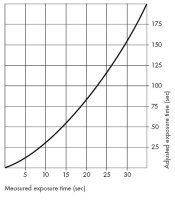Hi Pooblah,
Here is a link to the Ilford Pan-F+ product data sheet:
http://ilfordphoto.com/Webfiles/2006216115811391.pdf
I have attached the reciprocity curve for Pan-F+ to this message, and you will find that the frame in your roll that you metered at 15 seconds would have required 60 seconds, which means you exposed the film as if it were an ISO 800 film. Basically you underexposed by four stops.
If I were you I would focus on the correctly exposed frames and forget about this one, unless this particular frame is important to you and the other frames are not. Four stops is an awful lot, though, and it would be a compromise at best.
I have found that the best way to save underexposed negatives is by minimizing agitation and let the film sit in the developer for a very long time. But it is best to use a compensating developer such as Rodinal. Compensating means that it is designed to 'dampen' the development of the highlights, so to compress the tonal scale a little bit, while developing the shadows to full detail.
With stand development, you use your developer at high dilution, with Rodinal say 1+150. Agitate for the full first minute, then set the film tank down after you rap it hard on a counter top or similar (with a towel in between) to make air bubbles that stuck to the film during agitation dislodge and come to the surface. Then let the film sit for an hour without doing anything to it.
What this will do for you is it will take your 'normal' frames and develop
those 'normally' while frames that received less exposure will get a boost, and those that were overexposed will be held back to some degree.
Like all other developing schemes - there is no real magic bullet to salvage poor exposure. But this works pretty well to even out differences in exposures of say two stops. More deviation and even this technique will become a compromise. And you really should do some testing to see what can be done, perhaps by trying to duplicate the exposure situation you have now on another roll and try it at different dilutions and times to reach the best compromise between under- and overexposure.
What it boils down to is this - either you try to save the frame you underexposed by prolonging development (and it will be a compromise with poor contrast), or you develop the 'normal' frames like you always do and live with the failure.
I hope that helps.
- Thomas
BTW - Here's Gainer's article:
http://www.unblinkingeye.com/Articles/LIRF/lirf.html
i was shooting pan 50 (i'm assuming it's similar to pan 100 as listed on the chart?) and unfortunately i mixed in 15 second exposures with 1/30 second exposures on the roll without really thinking about it... i suppose i could push to, say, EI 64 to try and get the most out of the entire roll.
basically the point of my original question was, is the latitude of b/w film so great that i can compensate for reciprocity failure on the enlarger in most cases? i'm developing the rolls tomorrow and i do want everything to come out okay. i'll find out the answer to my question soon enough, i guess...
btw what is the 'Stand' development scheme?













